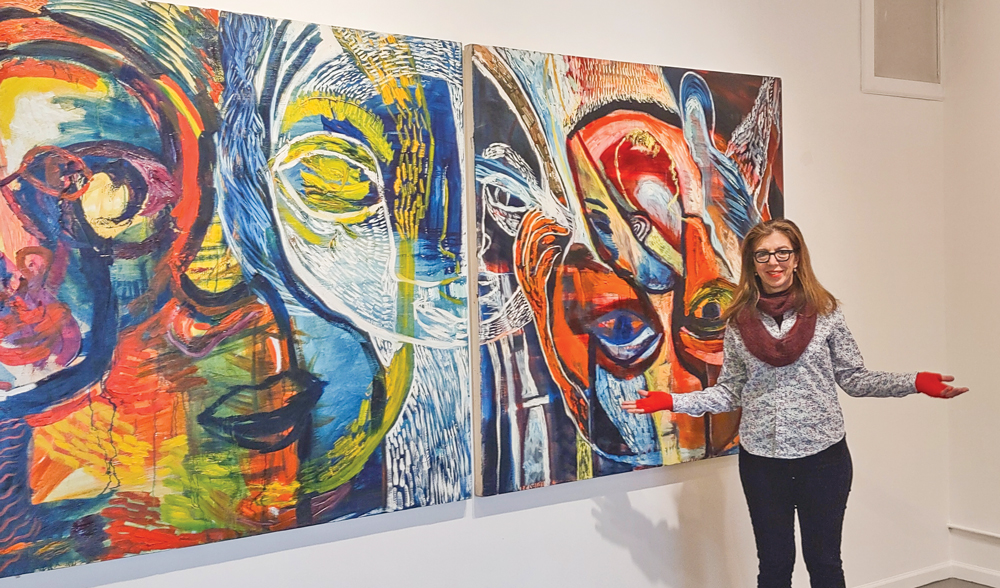SGI-USA member Kryssi Staikidis is a painter, professor and head of Art and Design Education at the Northern Illinois University School of Art and Design. In 2021, she was conferred the National Art Education Association’s June King McFee Award for her research and art, teaching practices that focus on community, inclusivity and social justice.
World Tribune: Thank you for speaking with us. What brought you to art and academia?
Kryssi Staikidis: Painting has always been my dream for as long as I can remember. I was always a narrative painter, telling stories through my painting. When I encountered Buddhism, I wanted to express this great practice in painting, telling stories of life, death and human enlightenment. In my early 20s, I moved to Ecuador where I observed Andes Indigenous communities making art in the midst of daily life while tending to agriculture.
WT: How did you come across Buddhism?
Staikidis: I was first introduced to Buddhism in Ecuador by a fellow New Yorker [and teacher] at an elementary school where I taught art to kindergarten through sixth grade students. One day I asked her how she stayed so calm with her 7-year-old twins climbing all over her. She said, “I chant Nam-myoho-renge-kyo.”
Although I heard her, I was opposed to organized religion. I’ve always been a combination of fiercely independent and simultaneously insecure. That’s always been my karma, my mission.
A year after I returned to the U.S., I started practicing Buddhism. I resisted the idea of the mentor-disciple relationship, but my SGI leaders put a copy of The Human Revolution in my hands. That is how I got to learn about Ikeda Sensei as a disciple of second Soka Gakkai President Josei Toda. This showed me how I, too, might reply to my mentor, so I made a determination to Sensei to be an artist for kosen-rufu. But my career took many turns.
WT: How so?
Staikidis: At one point, I didn’t know what to do, what to paint about. I got guidance about it, and the answer was, “Why don’t you teach? Then you will have something to paint about.”
I taught for many years in communities where there was huge [inequity] in schools. My sense of social justice grew.
I had another turning point with Sensei when I supported his [June] 1996 movement in New York.
WT: What happened?
Staikidis: At the time, I was an art teacher, and Sensei gave his talk on global citizenship at Teachers College [at Columbia University]. I wanted to be inside attending the lecture, but then I realized on a deeper level the beauty of supporting Sensei’s movement. I decided in that instant: I’m going to go to Teachers College to seek a doctoral degree and pursue a path in global citizenship based on art!
It emerged out of my life that I wanted to share in Sensei’s vision [and] become a professor.
WT: How did your path unfold?
Staikidis: Based on my earlier years living in Ecuador and observing Indigenous weaving made in daily life, I knew what to do: I would seek out Maya painting mentors to learn and share their painting approaches rooted in personal and cultural stories.
My studies were all about painting pedagogy, always asking myself, “How do I go back to my experience as a female student who didn’t fit in a compartmentalized, Western space to broaden our Eurocentric teaching by including Indigenous perspectives?”
WT: How has your Buddhist practice impacted your work?
Staikidis: My work now is focused on honoring students as human beings and helping them to foster such ideals as they go out to teach their own young students. And all of this relates back to my Buddhist practice and thinking about the tenets of value creation.
[Also,] it has been about challenging my lack of confidence. Not being Indigenous, I’ve always felt conflicted about my work. So receiving the National Art Education Association’s June King McFee Award last year was such an affirmation from elders and pioneers in the field for the work I’ve done.
I sought guidance before my recent art exhibition in Chicago because I wasn’t getting my announcements out, as I was nervous. My senior in faith said, “Any victory is a victory that protects the mentor.” Recently, I was informed that I had been awarded my university’s Presidential Engagement Professorship based on my two decades of work with Maya painting mentors in reply to Sensei’s vision of global citizenry.
For so long, as a student, I was always afraid. Focusing on approval, worrying about how I was going to be received—that was always my devilish function. I felt I was finally able to show my work and feel confident. It was such a breakthrough. For the first time ever, I felt so proud at the opening of my art show.
WT: What is your determination for the future?
Staikidis: My dream is to be a world-renowned painter for kosen-rufu. I’ve been sending photos of my artwork and determinations to Sensei since my 20s. It’s something I still want to win in, and I feel I have a long way to go. But my mission as a painter and primordial identity as a Bodhisattva of the Earth are intertwined.
You are reading {{ meterCount }} of {{ meterMax }} free premium articles

